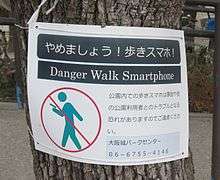Smartphone zombie
Smartphone zombie or ‘Smombie’ has been used in popular culture to describe pedestrians who walk slowly and without attention to their surroundings because they are focused upon their smartphone. Safety hazards have been noted due to such distracted pedestrians. Cities such as Chongqing and Antwerp have introduced special lanes for smartphone users to help direct and manage them.[1][2] Whilst used in some countries more than others, the terminology was suggested to be pejorative by Tom Chatfield of the BBC, noting it is "more sinister", "suggests disapproval of (the) subject(s)" and that "terms of technological disapproval, conjured from hyperbolic hopes and fears, are as old as electronic communications."[3] A 2017 review considered the popular culture term in regards to the medical diagnoses of internet addiction disorder and other forms of digital media overuse.[4]

Prevalence
In Chongqing, China, the government constructed a dedicated smartphone-sidewalk, separating the phone users and the non-phone users.[5][6] In Hong Kong, they are called dai tau juk (the head-down tribe).[7]
Mitigation

Texting pedestrians may trip over curbs, walk out in front of cars and bump into other walkers. The field of vision of a smartphone user is estimated to be just 5% of a normal pedestrian's.[8] An app which uses the phone's camera to make it seem transparent can be used to provide some warning of hazards.[9] In Augsburg, Bodegraven and Cologne, ground-level traffic lights embedded in the pavement have been introduced so that they are more visible to preoccupied pedestrians.[10][11] In Seoul, warning signs have been placed on the pavement at dangerous intersections following over a thousand road accidents caused by smartphones in South Korea in 2014.[12] In October 2017, the City of Honolulu, Hawaii introduced a measure to fine pedestrians looking at smartphones while crossing the road.[13] In 2019, China introduced penalties for "activities affecting other vehicles or pedestrians" and a woman was fined 10 yuan in Wenzhou.[14]
History
Science fiction author Ray Bradbury predicted the phenomenon in the 1950s in his stories such as The Pedestrian and Fahrenheit 451.[15][16][17] He wrote at the time how he observed it actually starting to happen in Beverly Hills,
"Elsewhere in the narrative I described my Fire Man arriving home after midnight to find his wife in bed afflicted with two varieties of stupor. She is in a trance, a condition so withdrawn as to resemble catatonia, compounded of equal parts liquor and a small Seashell thimble-radio tucked in her ear. The Seashell croons and murmurs its music and commercials and private little melodramas for her alone. The room is silent. The husband cannot even try to guess the communion between Seashell and wife. Awakening her is not unlike applying shock to a cataleptic.
I thought I was writing a story of prediction, describing a world that might evolve in four or five decades. But only a month ago, in Beverly Hills one night, a husband and wife passed me, walking their dog. I stood staring after them, absolutely stunned. The woman held in one hand a small cigarette-package-sized radio, its antenna quivering. From this sprang tiny copper wires which ended in a dainty cone plugged into her right ear. There she was, oblivious to man and dog, listening to far winds and whispers and soap-opera cries, sleepwalking, helped up and down curbs by a husband who might just as well not have been there. This was not science fiction. This was a new fact in our changing society."— Ray Bradbury, The Nation[18]
See also
- Jaywalking
- Mobile phones and driving safety
- Mobile phone overuse
- Phubbing
- Pokémon Go, a mobile game designed to be played outdoors
References
- Leo Benedictus (15 September 2014), "Chinese city opens 'phone lane' for texting pedestrians", The Guardian
- David Chazan (14 Jun 2015), "Antwerp introduces 'text walking lanes' for pedestrians using mobile phones", Daily Telegraph, Paris
- Chatfield, Tom. "The new words that expose our smartphone obsessions". www.bbc.com. Retrieved 2019-01-22.
- Duke, Éilish; Montag, Christian (2017), Montag, Christian; Reuter, Martin (eds.), "Smartphone Addiction and Beyond: Initial Insights on an Emerging Research Topic and Its Relationship to Internet Addiction", Internet Addiction: Neuroscientific Approaches and Therapeutical Implications Including Smartphone Addiction, Studies in Neuroscience, Psychology and Behavioral Economics, Springer International Publishing, pp. 359–372, doi:10.1007/978-3-319-46276-9_21, ISBN 9783319462769
- David Raven (15 September 2014), "World's first mobile phone walking lane for 'zombie pedestrians' addicted to texting", Daily Mirror
- Heather Chen (7 September 2015), Asia's Smartphone Addiction, Singapore: BBC News
- Mark Sharp (2 March 2015), "Beware the Smartphone Zombies Blindly Wandering Around Hong Kong", South China Morning Post
- "Japan's smartphone 'zombies' turn urban areas into human pinball", Japan Times, 17 November 2014
- Peter Apps (31 March 2014), "'Transparent' iPhones: A text and walk plan for those trying to do two things at once", Independent
- Pavement lights guide 'smartphone zombies', BBC, 16 February 2017
- Janek Schmidt (29 April 2016), "Always practise safe text: the German traffic light for smartphone zombies", The Guardian
- Max Bearak (21 June 2016), "Seoul wants 'smartphone zombies' to read road signs instead", Washington Post
- Brett Molina (25 October 2017), "Looking at your phone while crossing the street will cost you in Honolulu", USA Today
- George Pierpoint, Kerry Allen (17 January 2019), 'Smartphone zombie' fine cheered on Chinese social media, BBC News
- Jeff Miller (24 October 2014), "Put down the smartphone and make a real connection", Augusta Chronicle
- Jordan Oloman (16 May 2016), "Word of the Year: SMOMBIES", The Courier
- Hayley Tsukayama (7 June 2012), "10 Ray Bradbury predictions that came true", Washington Post
- Ray Bradbury (2 May 1953), "The Day After Tomorrow: Why Science Fiction?", The Nation
Further reading
- Hookham, Mark; Togoh, Isabel; Yeates, Alex (21 February 2016). "Walkers hit by curse of the smombie". The Sunday Times. UK.
- Hatton, Celia (15 September 2014). "Chongqing's 'mobile lane'". BBC News. UK: BBC.
External links
